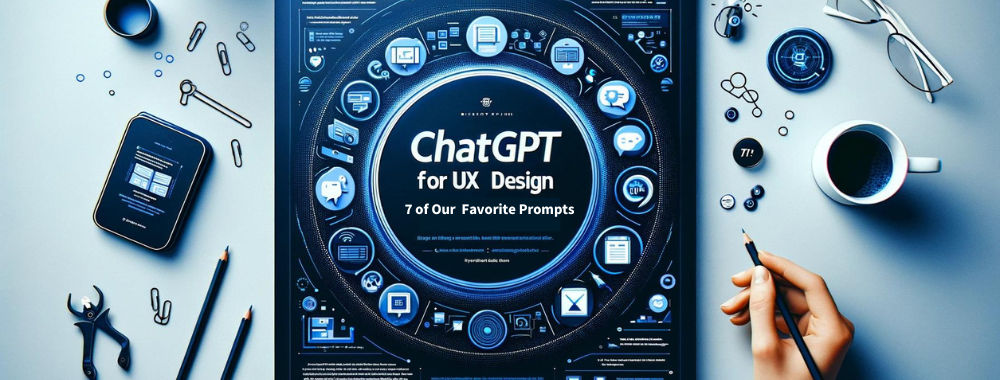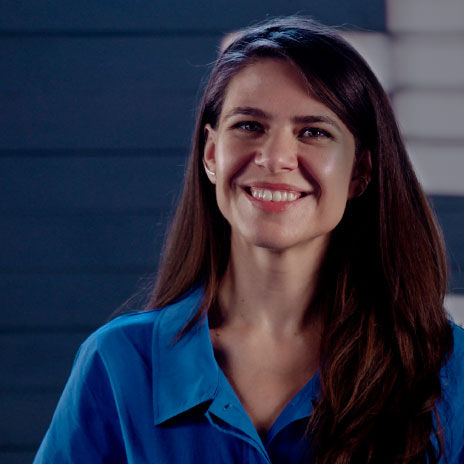Your creative process is a precious part of how you design—as in, it’s the engine behind it all. And in the era of ChatGPT—a real game-changer in design—there’s one question in particular that might be top of mind: How can the worlds of artificial intelligence (AI) and user experience (UX) design come together to totally revolutionize that process?
In November 2022, ChatGPT amazed with how versatile it was, and, by March 2023, the latest version and other chatbots (like Microsoft Copilot, Bard AI, OpenAI playground) had added features such as video analysis and multi-modal capabilities.
This AI powerhouse keeps on shaping everything in the world around us—and that spans from healthcare to entertainment—and, you guessed it, UX design isn’t an exception. Now, you can collaborate with ChatGPT for a whole variety of productive purposes: to brainstorm innovative designs, get deep user insights, and even—yes—craft user personas, those much-needed tools.
Show
Hide
video transcript
- Transcript loading…
Are you excited to learn more? Here's everything you need to know about using ChatGPT for UX design.
Why Should You Implement ChatGPT in Your UX Design Process?
Show
Hide
video transcript
- Transcript loading…
Let’s make no mistake about something first off—and that’s how it’s a vital thing to stay ahead in any industry, but how that’s especially so when it comes to the careful craft and design of products for users who’ve got ever-changing expectations. More precisely, if you’re to stay ahead in UX design, it means you’ll need to adopt new tools, technologies, and methodologies. Happily, ChatGPT’s got a suite of advantages that every UX designer should consider taking up—and, namely, we’re about to get into the capabilities of ChatGPT 3.5 and ChatGPT 4.
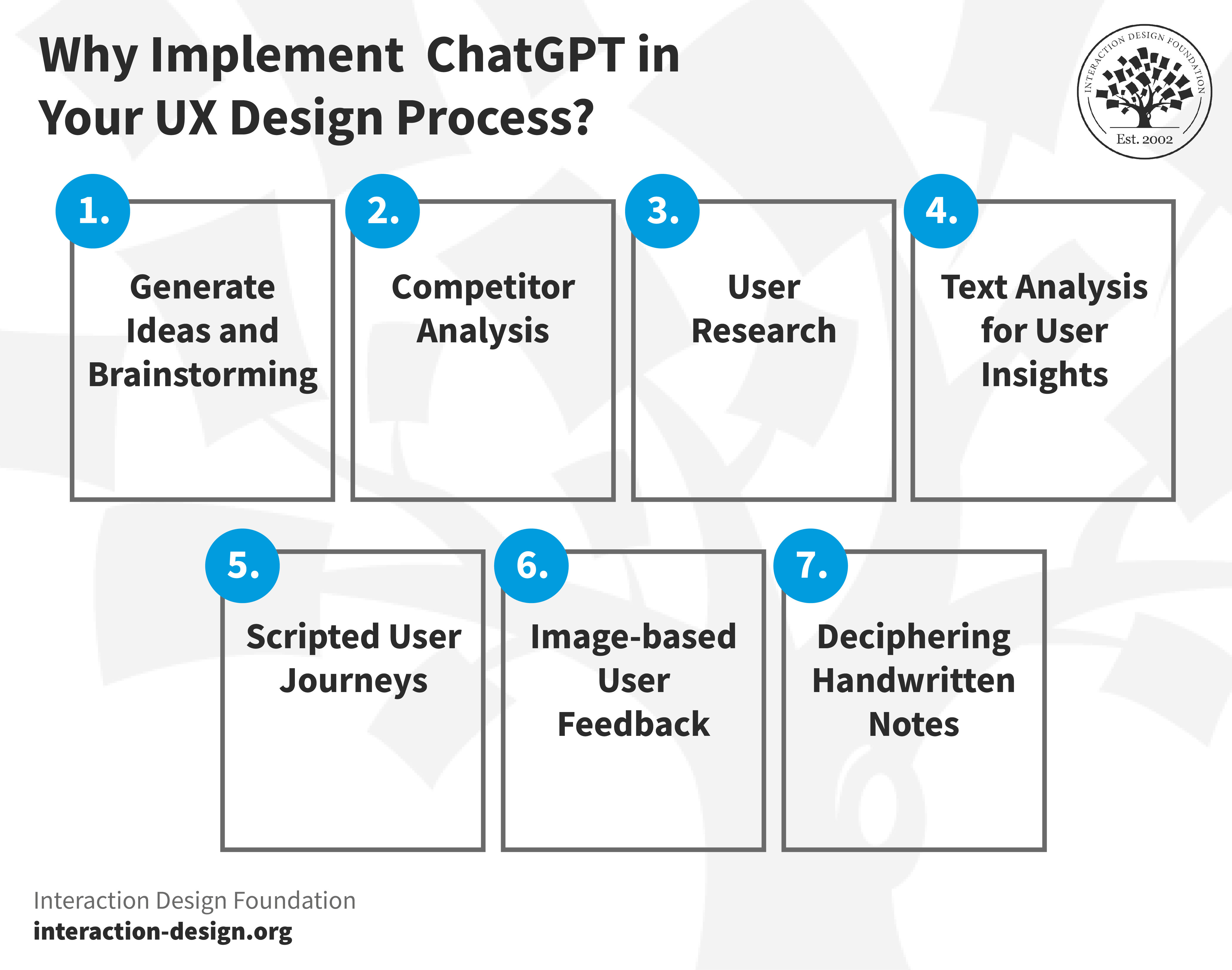
© Interaction Design Foundation, CC BY-SA 4.0
1. Generate Ideas and Brainstorming
Feeling stuck? Or maybe you think you need a perspective that’s nice and fresh? ChatGPT can help a great deal in brainstorming sessions. So, go on and give it a design problem or scenario, and the AI can generate a list of potential solutions for you that are based on its database. And—while it won’t replace the understanding that a seasoned designer’s got—it can provide new angles that’ll shed light on important areas and things.
2. Competitor Analysis
How about those large data sets? Well, ChatGPT can synthesize them, and that includes reviews or feedback that competitors get, and all you’ve got to do is collect the data from publicly available sources and feed it to the tool. And when you know what your competition does—right or wrong—through SWOT analysis, that can help you curate your design strategy nicely.
3. User Research
Sure, it may not be a substitute for user studies, but here’s a juicy plus: ChatGPT can simulate common user queries or pain points. So, look on it as a mock interview, and it’ll help you get an idea of what real users might need or ask. For example, ChatGPT could simulate user questions about booking flights, lodging, or doing tours if you're designing a travel website—and that’s a handy way to get a few steps ahead of what your soon-to-be customers are in the market for.
4. Text Analysis for User Insights
Imagine a user leaving a lengthy review of your app's interface—for the better or for the worse, maybe even bits that seem middlingly neutral in there. A neat thing that the AI can do here is analyze this text, extract key insights, and even categorize them into aspects like "usability," "aesthetics," or "functionality." That’s a helpful way for how you can understand what users love—or hate—without your having to wade through mountains of text yourself.
5. Scripted User Journeys
Another key thing, and area, where ChatGPT excels is how it can make customer journeys for testing. And, yes, you can program it to guide a user through a series of tasks on your application—and collect data at each and every step. It can ask questions like, "Was it easy to find the 'contact us' button?" and collect real-time responses. That’s a neat plus, since it doesn’t just replace the need for manual A/B testing but gives you better, more contextual data, too.
Watch this video to understand the power of journey mapping and turn your insights into viable initiatives.
Show
Hide
video transcript
- Transcript loading…
6. Image-based User Feedback
Imagine you've designed a new interface and got your user feedback in, and—what’s more—users can now upload screenshots of the issues they run into. ChatGPT 4 can analyze these images, identify design elements, and give actionable insights for you to work with—that’s a nifty feature that leads nicely into a streamlined feedback loop.
7. Deciphering Handwritten Notes
Design workshops—and this is especially when they’re at their creative and intense best—often find participants cranking out a healthy volume of handwritten notes, sketches, and wireframes. Sounds pretty free-form—“organic” cursive and freestyle drawing, for instance—but it’s not just capturable and decodable—it’s analyzable, too. Yes, ChatGPT 4 is able to read and interpret this handwritten content, and—best of all, maybe, as far as you’re concerned—it can give you a structured summary of what you discussed. That way, you can make good and sure that you don’t lose valuable insights in the shuffle.
That’s quite a haul of neat plusses—so, now that we’re intrigued and ready, let’s get on to the actual prompts. You can use—and modify—these seven prompt examples so you get better results to enjoy and use. What’s more, learn how to use Chat GPT for UX design—and get ready to enjoy the many benefits.
Remember one thing, though: ChatGPT can only help you to enhance the quality of work—as in, it’s not a replacement for your efforts—so don’t treat it as a kind of “autopilot” to handle everything.
Prompt Example 1: User Research
Help us outline the Who, Why, What, and How of our new fitness app. We aim to address specific user pain points and would like to ensure that our design aligns with these factors.
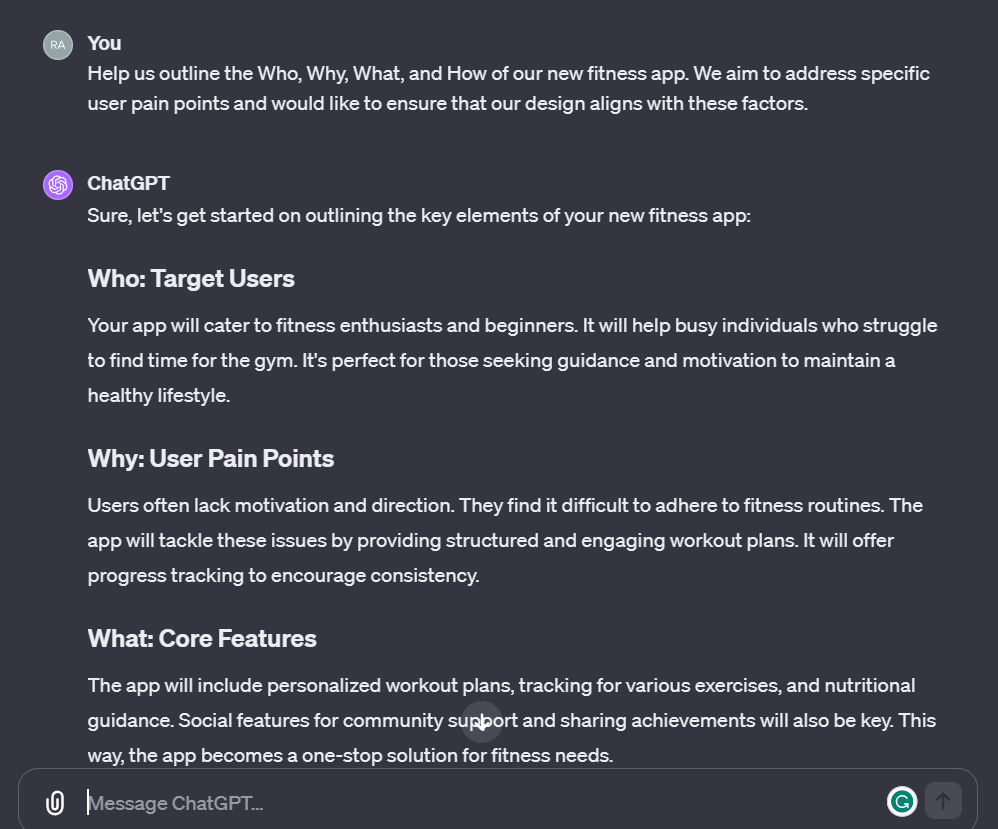
© OpenAI, Fair use
The Who, Why, What, and How are four pillars that make up what’s a vital part of the design thinking process—and it’s something that gives that powerful lift to help you meet user needs. These questions are heavyweights and they’re ones that target the user demographic, the problems that the product solves, its key features, and how users interact with it—the vital areas that, when you’ve got the right answers, will help to get you behind your users so much better.
Why This Particular Prompt?
This prompt is big-time useful; it gives you a comprehensive overview of the most crucial aspects of product use—and it’s a crucial item that helps get design features in line with user expectations and needs. Better user research is a vital ally in your toolkit; it paves the runway from which a compelling and engaging user experience can take off with your design efforts—and that’s just the ticket for a winning design to go places with its users and go far in the marketplace.
Watch this video to learn when to do user research.
Show
Hide
video transcript
- Transcript loading…
Video copyright info
- Images
- Copyright holder: Unsplash. Copyright terms and license: CCO Public Domain. Link: https://pixabay.com/en/clay-hands-sculpting-art-69...
- Copyright holder: Unsplash. Copyright terms and license: CCO Public Domain. Link: https://www.pexels.com/photo/man-in-black-shirt-an...
- Copyright holder: Indecent Proposer. Copyright terms and license: CC BY-NC 2.0 Link: https://www.flickr.com/photos/indecent_proposal/14...
- Copyright holder: Anna Langova. Copyright terms and license: CC0 1.0 Link: http://www.publicdomainpictures.net/view-image.php...
- Copyright holder: Conmongt. Copyright terms and license: CC0 Public Domain Link: https://pixabay.com/en/hourglass-time-time-lapse-clock-1623517/
How Can ChatGPT Help?
ChatGPT can neatly provide a structured breakdown of each of these aspects, and—what’s more—it can generate questions or prompts that help you explore those big points: the intended user base, key functionalities, user pain points, and interaction flows.
Why Is It More Effective than Conventional Methods?
If you were to try for these insights “conventionally,” you might well find it a time-consuming affair and—not just that—going with other methods might make you miss key insights that ChatGPT can get you. The detailed and structured analysis that ChatGPT can serve up for you can help you save a lot of time and—potentially—uncover aspects you’d have otherwise overlooked.
What to Consider Before Using ChatGPT?
Before you get using ChatGPT here, it’s pretty much vital that you’ve got a basic understanding of the product, its goals, and its target audience, and that’s because ChatGPT's analysis will be more precise and of benefit to you when you’ve given it more information.
Prompt Example 2: User Interview Questions
Generate a set of user interview questions aimed at understanding the user experience of an e-commerce website. Focus on elements like ease of navigation, search functionality, and checkout.
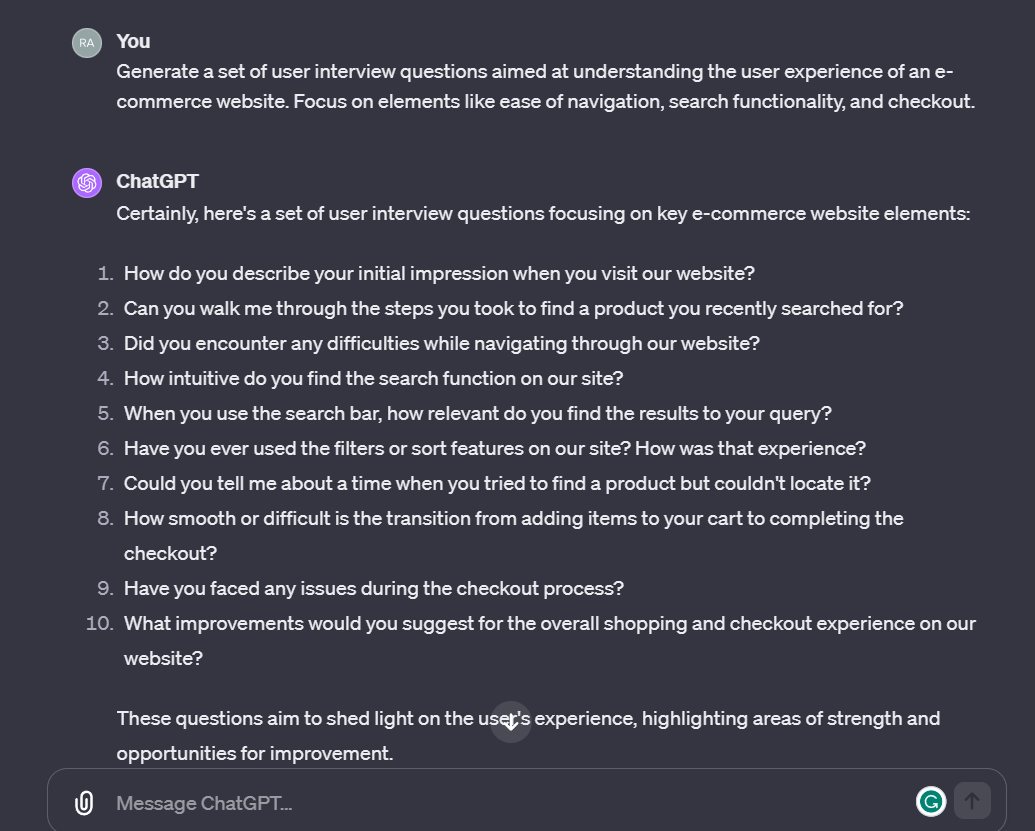
© OpenAI, Fair use
Many people conduct user interviews, and they’re a great way to get in direct insights from the people who use a product, or service. Interviews can be full of precious nuggets that tell you what users like, what they don’t—or struggle with, sometimes the same thing—and how they look on a design. Sure, you can mine these nuggets to help steer yourself towards better design choices and user-friendlier interfaces.
But let’s step on the brakes for just a moment and look at a vital fact here—interviews are only as effective as the questions that users end up encountering—and it’s critical to ask the right questions, therefore. Users have got limited time, and patience, so you won’t want to waste their time with irrelevant or unclear questions. You’ve got to pick the right questions so you can avoid wasted time and get responses that are truly precious and in the interests of good—if not great—design.
Watch this video to understand how to order questions in your user interviews.
Show
Hide
video transcript
- Transcript loading…
Why This Particular Prompt?
User interviews are foundational in UX design—and it’s pretty much impossible to overstate how fundamental they are for designers to get in the nuggets they need to feed and fuel successful designs that really resonate with their user base.
Not for nothing, then, will you want to craft questions that have great impact—so you’ll be able to get actionable insights which you can work into your design choices.
How Can ChatGPT Help?
ChatGPT can come up with a set of targeted questions to extract relevant information from users—a major boost where it can tailor these questions from your project’s scope and goals so they’re in tune with where you want to take things.
Why Is It More Effective than Conventional Methods?
Time and best practices, really—as in, the AI takes just a fraction of how long it’d take a human to create questions, plus you can get the most from each interview, too, since it uses the best practices in question design.
What to Consider Before Using ChatGPT?
Know where you’re headed and how—as in, make sure you’re aware of the goals and the scope of your user interview and give ChatGPT this info so you get questions that are relevant to your project.
Prompt Example 3: Tools for Specific UX Design Tasks
Recommend tools designed for creating high-fidelity prototypes. Include tools that offer real-time collaboration features and are easy to learn for beginners.
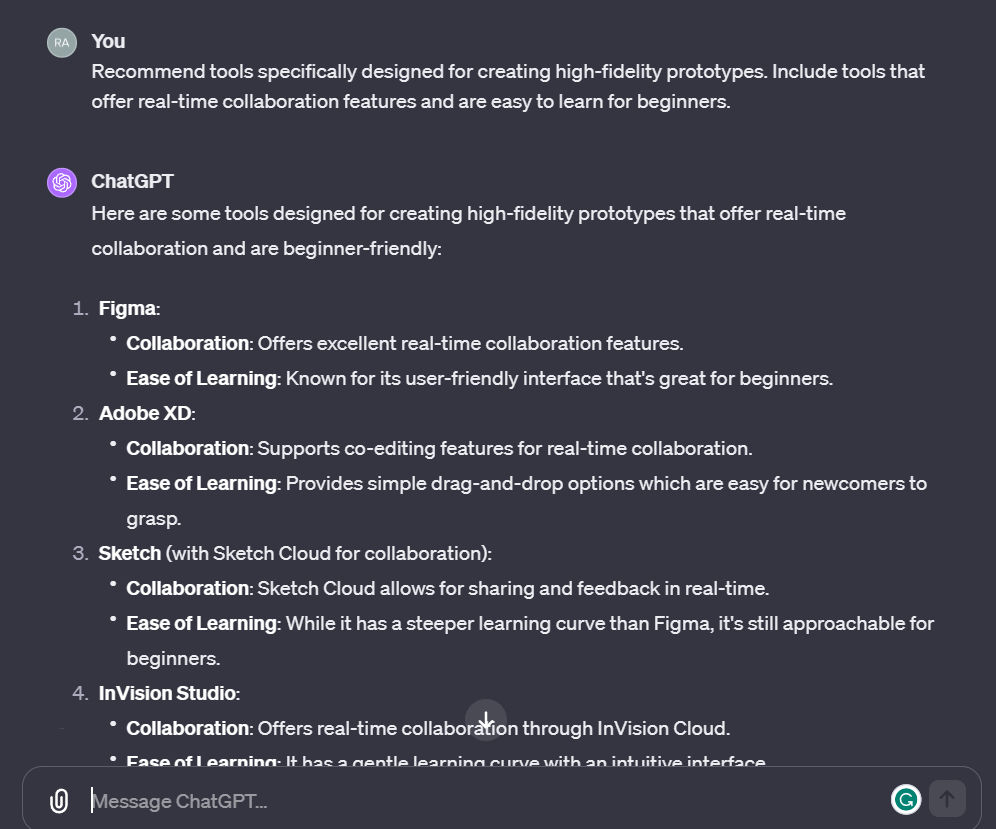
© OpenAI, Fair use
You need a variety of UX design tools for different purposes—ranging from sketching and wireframing to user testing and prototyping—and when you know which tool goes above and beyond in what area, it can save you serious time and effort, like, for example, not using a graphic design tool for wireframing when you’ve got specialized tools to turn to.
Why This Particular Prompt?
Pick tools that are right for what you needs are—and for what you need to do—not least as the right tool can save you a lot of headaches later on.
How Can ChatGPT Help?
Whatever the type of UX design task you’re working on, ChatGPT can offer you not just a list of tool recommendations but even insights into the pros and cons of each of those tools, too.
Why Is It More Effective than Conventional Methods?
It takes ChatGPT a mere matter of seconds to serve up a tailored list for you, and that’s a lot better than spending time searching and comparing tools. The only thing you’ve got to do is pick the best fit for what your needs are.
What to Consider Before Using ChatGPT?
Help ChatGPT help you—as in, with more targeted tool recommendations that are a fit for your project—and be specific about what kind of UX task you’re focusing on.
Prompt Example 4: User Personas
Please create detailed user personas for a music-streaming app. Consider factors like age, location, musical preferences, and usage habits. Also, focus on how to increase user engagement.
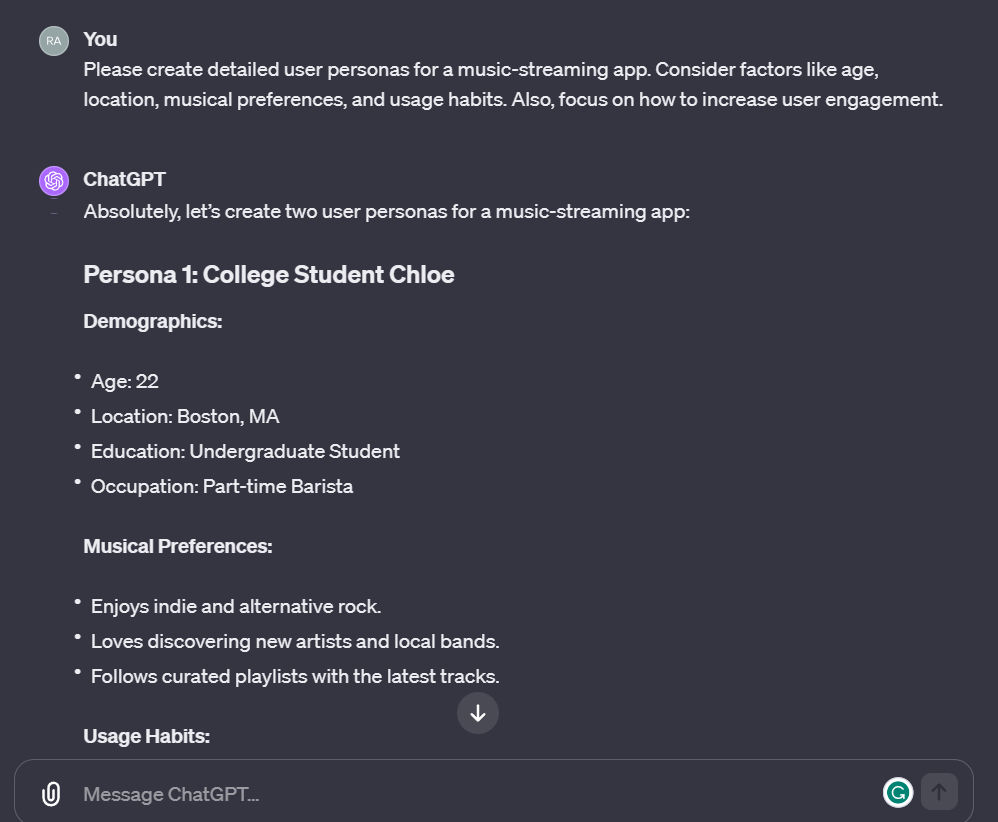
© OpenAI, Fair use
User personas are a staple tool in UX design, which means that it’s pretty much a foregone conclusion that UX designers will soon get to grips with creating these vital deliverables; after all, personas are what provide—or “embody”—a concrete idea of who the end users are—and, as long as they’re good ones, they’ll help designers understand user needs, behaviors, and motivations in sharp relief.
Often, designers collect data from interviews, surveys, and other sources so they’ll have a solid launchpad from which to build and launch these personas, and the more detailed and precise a user persona is, the better you’ll be positioned to tailor your design so it really meets the needs of who’s in your user base.
Why This Particular Prompt?
User personas really serve as the foundation for any design project—and a well-constructed persona is a nifty asset that can guide your design choices to some pretty fine destinations and so help make your product more user-focused.
How Can ChatGPT Help?
ChatGPT can not only generate in-depth user personas from the data and project goals you feed it with, but outline the demographic information, needs, pain points, and behaviors that are critical to your design process, too.
Why Is It More Effective than Conventional Methods?
ChatGPT’s time-saving powers again come into play, this time in the persona-creation process, as the AI can generate detailed personas quickly and so spare you hours of compiling and analyzing data, and in the process let you focus on the actual design.
What to Consider Before Using ChatGPT?
It’s really a must to make sure you’ve got an excellent initial data set and clear project goals, and that’s as they’ll guide ChatGPT in creating relevant—and valuable—personas for your design project.
Prompt Example 5: Color Schemes
Recommend color schemes appropriate for a health and wellness app. Consider factors like user mood, trustworthiness, and readability.
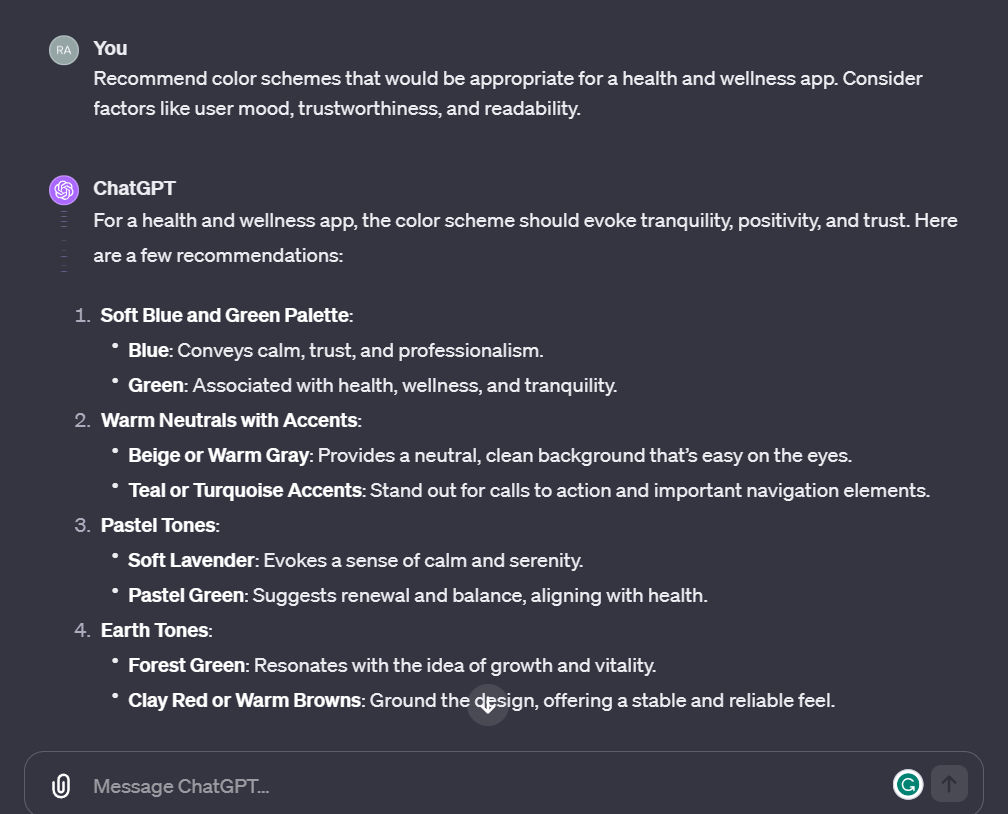
© OpenAI, Fair use
Color schemes are—as in the physical world—massively important, to say nothing of influential in the role they play in UX design, and that’s because of not just how they set a website or app’s visual tone but how big an impact they have on user engagement, too. Apart from the point that colors are strong influencers of emotions, that they guide attention and even affect readability, they help create visual hierarchy, too, and put emphasis on essential elements (think buttons and calls to actions here, for example).
Cultural context plays a huge part in determining how different colors affect people in different ways, like red’s carrying signals of danger and excitement in the West, yet good fortune in the East. So, it pays to think through the color palette before the design’s message speaks to encourage specific kinds of user behavior when users engage with the brand.
Watch this video with Joann and Arielle Eckstut, leading color consultants and authors, to get six top tips on how to choose colors.
Show
Hide
video transcript
- Transcript loading…
Why This Particular Prompt?
Colors have got the potential to be a major driving force in the vital areas of not only user engagement but user retention as well, so, for an app, for instance, it’s vital to pick a color scheme that resonates with its purpose and the emotions you want to tap and bring out.
How Can ChatGPT Help?
ChatGPT can analyze trends and best practices in color theory and then suggest color schemes that are in line with a health and wellness app’s objectives—and it’s something that can include specific color codes and combinations.
Why Is It More Effective than Conventional Methods?
You may find researching and selecting color schemes time-consuming due to the research and data you’d need to put in. ChatGPT can quickly provide options based on proven principles—a really nice touch that doesn’t just save you time but encourages data-driven choices too.
What to Consider Before Using ChatGPT?
You’ll need to be clear about what emotions—and reactions—you want your color scheme to evoke, and that’s information that’s going to help ChatGPT generate recommendations that run best in line with what your app’s goals actually are.
Prompt Example 6: Improving Wireframes
Analyze this wireframe for our mobile travel booking app and suggest improvements for a smoother user flow. Focus on elements like menu placement, button sizes, and the arrangement of form fields.
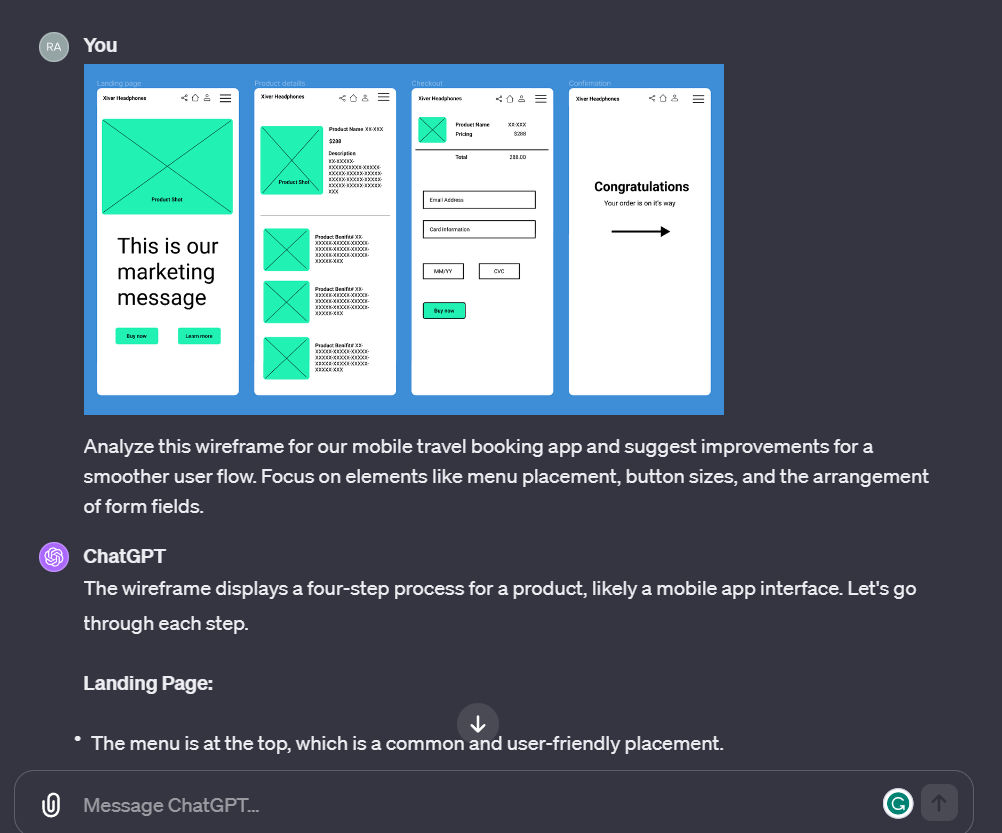
© OpenAI, Fair use | Wireframe from © Dribbble, Fair use
Wireframes are another big staple in UX design—as they outline the skeleton of a website’s user interface—and if you improve the wireframe, you’ll be able to enhance the user experience. How? By making navigation all the more intuitive and elements so much more accessible, but, with that said, it can be a complex thing to pinpoint the areas that call for tweaking in a wireframe.
Why This Particular Prompt?
If you’re going to optimize user flow and the overall experience, then it’ll take making improvements to wireframes, and specific, actionable suggestions can help you design an app that’s way more efficient and enjoyable.
How Can ChatGPT Help?
So, you’re going to need to understand just how you can improve the wireframe, and ChatGPT can view and analyze it—you’ve just got to describe specific elements of it so the AI can give you better insights, suggesting things such as best practices in menu placement, button sizing, and other layout decisions.
Why Is It More Effective than Conventional Methods?
Traditionally, or conventionally, you’d have to do multiple iterations as well as extensive user testing to make wireframe improvements, but ChatGPT can lessen the number of iterations and tests you’d need to make, and that’s thanks to the suggestions it can give based on design best practices.
What to Consider Before Using ChatGPT?
It’s important to have a detailed description or list of elements in the wireframe to share with ChatGPT, and the more specific you can get, the more targeted you’ll find the AI's suggestions will be.
Prompt Example 7: Understand UX design terminology
Could you explain the term 'Information Architecture' in a way that anyone can understand without using jargon? Use an example to explain thoroughly.
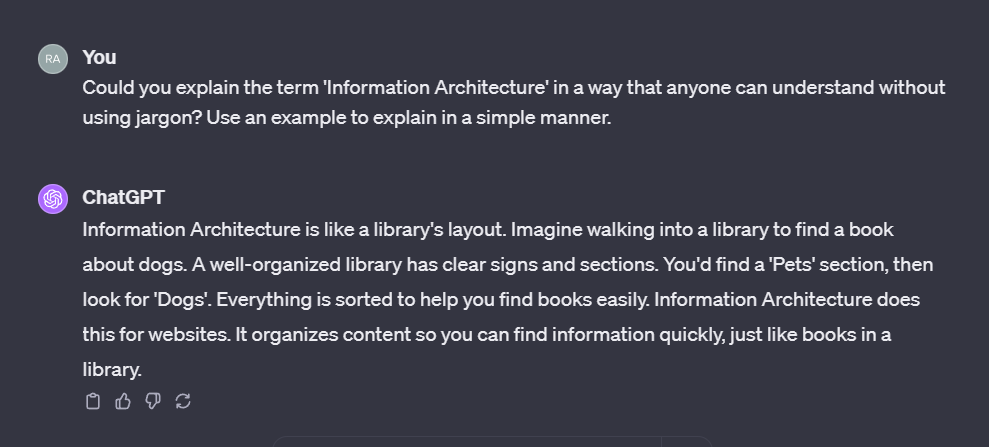
© OpenAI, Fair use
Like other disciplines, UX design is no stranger to specialized terms—or, dare we say, jargon—and these are the kinds of words that may well sound like a foreign language to clients or stakeholders who aren’t familiar with the UX world. Simple language is the way to go, therefore, not just for more engaging and understandable presentations that you’ll give but better collaboration and decision-making, too.
Why This Particular Prompt?
It’s because to master design terminology and bring the right words to the appropriate audience, it’s all about making sure that everyone on board with the project speaks the same language and can therefore work better toward a project’s successful outcome. What’s more, you can use it to prepare better for the project, too.
How Can ChatGPT Help?
What ChatGPT can do here is simplify those complex UX terms into ones that team members who mightn’t have a design background can actually understand, and so make important design concepts accessible to them.
Why Is It More Effective than Conventional Methods?
If you were to try breaking jargon down into “user-friendly” terms, you might end up plowing tons of time into it, and maybe even have some unclear explanations to show for it for your trouble. Cue ChatGPT, your go-to source for simple, easy-to-understand definitions or explanations here.
What to Consider Before Using ChatGPT?
Be clear about your audience’s understanding of UX design—as in, what level they’re at—and you’ll help ChatGPT tailor the explanation so it’s as effective as it can be.
When You Don’t Want to Use ChatGPT for UX Design?
Show
Hide
video transcript
- Transcript loading…
Numerous advantages come with ChatGPT, sure, but still, there’ll be instances where you may not want to turn to it as an ideal solution in the UX design process, and let’s look at some reasons for why we’d advise you to exercise caution:
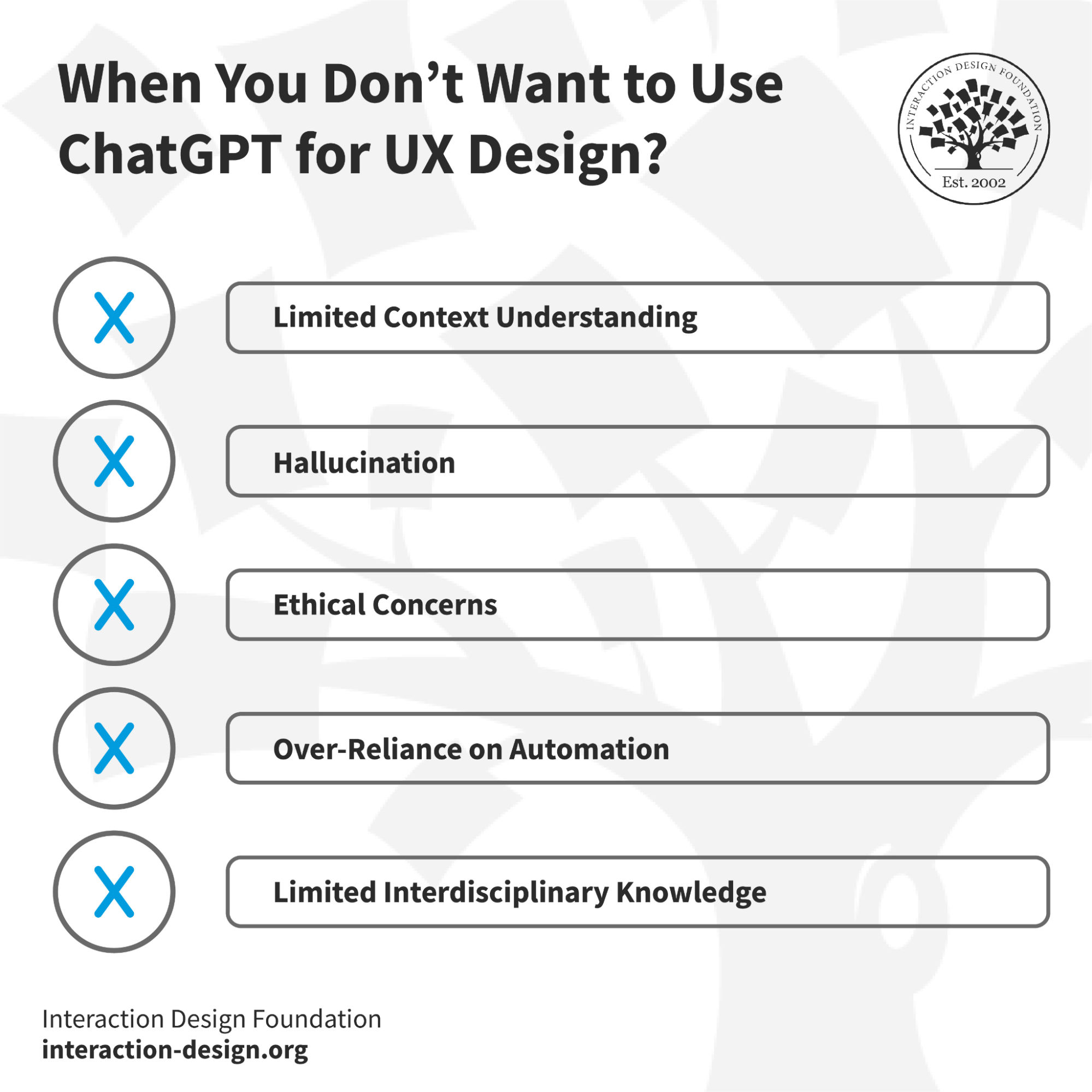
© Interaction Design Foundation, CC BY-SA 4.0
1. Limited Context Understanding
For all that it does and all that it can do, ChatGPT doesn’t have a deep understanding of the nuances and specifics that you’ve got going on in your project, and if you're designing a medical app, for example, ChatGPT won't know the latest trends or regulations in healthcare UX.
What to Do Instead: Consult with domain experts or do detailed user research for specialized tasks.
2. Hallucination
ChatGPT can spit out statistics or claims, but they mightn’t exist—hallucination territory—and misleading data can send you down the wrong design path, so beware. Imagine designing a color scheme based on false data about color psychology, and what could happen if the designer (and brand) went ahead and made a gaffe like, say, releasing an app aimed at children in an Eastern culture with a color scheme that lends itself more to mourning and funerary overtones.
What to Do Instead: Cross-check any data or information ChatGPT generates through reliable sources, just to be sure.
3. Ethical Concerns
There’s a chance that ChatGPT may create culturally insensitive material; and it’s a big point, for instance, that you wouldn’t want stereotypes—as in, ones that could exclude users from diverse backgrounds—creeping into your app’s UX. On a similar note, you may need to give some careful prompting to get ChatGPT to suggest accessible suggestions.
What to Do Instead: Review and edit the AI-generated content, and be sure to keep your varied user base well in mind.
4. Over-Reliance on Automation
Something that can happen is that if you overuse ChatGPT for every little aspect, it can diminish the human touch and “dilute” things on the human front a bit. The user interface should evoke emotions that artificial intelligence just can’t understand—so, be mindful of this and keep things “person-al.”
What to Do Instead: Use ChatGPT as a supplementary tool while you keep a high value placed on human input and creativity.
5. Limited Interdisciplinary Knowledge
ChatGPT has broad but shallow knowledge. What’s that mean? Well, for UX design in a specialized sector—like finance, say—you’d benefit more if you got to know user behavior through psychological and sociological lenses.
What to Do Instead: Collaborate with experts who are actually from relevant fields so you can better understand the user experience and what’s going on.
Know these limitations and you’ll find it’s a helpful kind of “compass” to keep you right—and that’s because it lets you decide when to use ChatGPT and when to rely on other methods or expertise.
So, What’s Next?
You’ve gone through a variety of ways that ChatGPT can helpfully boost your UX design process. These are a few examples of how this AI model can not just give you an edge but make your design process more efficient and effective, too, and here are some key takeaways for you:
ChatGPT can help you make questions that are precise and impactful, plus it makes your user research more actionable.
The AI can suggest the right tools for specific tasks, and it’s something that can be a time-saving boon in your design process.
ChatGPT’s detailed suggestions can improve user flow, and it can lessen the need for multiple iterations.
ChatGPT can help you do a lot, sure, but you’ve still got to understand what its limitations are and use it with care.
So, now you’ve got all this information about how to leverage ChatGPT for UX design—and do it well—why not think about these as being included in your next steps:
Identify your needs: Take a good look at how your design workflow is now and spot any areas that call for improvement or automation.
Experiment: Go ahead and try some of the ChatGPT prompts we’ve discussed out, and gauge how well the AI’s suggestions fit into your process as it stands currently.
Collect feedback: Take a look at the outcomes of tasks that get completed traditionally and compare them with those which ChatGPT aided and ask for feedback from your team members.
Optimize: Now take that feedback and the outcomes and tweak how you work ChatGPT into your workflow so you get the maximum benefit back.
Stay updated: AI is continually advancing—as in, it will continue to continue advancing—so be sure to keep an eye out for updates to ChatGPT or similar tools that might offer new features which your UX design process might benefit from.
Do incorporate ChatGPT into your design practice and take the steps you need to to make your workflow more efficient, but make sure you stay in the picture; don’t walk away and let it do everything as if it were a dishwasher. Always treat your interactions with ChatGPT as a partnership—one where you leverage its capabilities to improve your workflow with you very much in command of what you’re doing and where you’re taking things.
More Resources on ChatGPT for UX Design
Watch this masterclass by Ioana Teleanu on AI-Powered UX Design: How to Elevate Your UX Career.
Get this e-book on ChatGPT for UX/UI Design: Top Prompts and Expert Tips for Maximum Impact.
Watch Anirudh Palaskar explain how to use ChatGPT for UX design.
References and Where to Learn More
Take our AI for Design course to incorporate artificial intelligence (AI) tools into your design process and learn how to design for AI.
Show
Hide
video transcript
- Transcript loading…
Check out this article to learn What is Artificial Intelligence?
Learn more about the capabilities of ChatGPT 4.
Take this course on how to design and develop apps using GPT 4 and Midjourney.
Get a broader view of UX Research here.
Join this course to master user research and get an industry-recognized course certificate.
